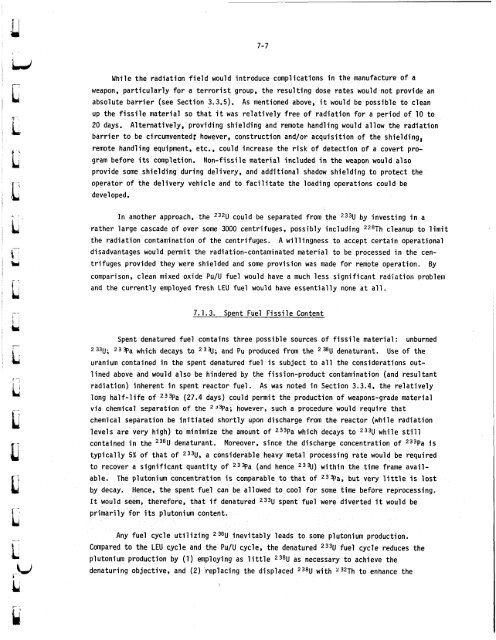ORNL-5388 - the Molten Salt Energy Technologies Web Site
ORNL-5388 - the Molten Salt Energy Technologies Web Site
ORNL-5388 - the Molten Salt Energy Technologies Web Site
Create successful ePaper yourself
Turn your PDF publications into a flip-book with our unique Google optimized e-Paper software.
L<br />
a,<br />
-<br />
L<br />
i --<br />
k;<br />
L<br />
t IJ<br />
L<br />
7-7<br />
While <strong>the</strong> radiation field would introduce complications in <strong>the</strong> manufacture of a<br />
weapon, particularly for a terrorist group, <strong>the</strong> resulting dose rates would not provide an<br />
absolute barrier (see Section 3.3.5). As mentioned above, it would be possible to clean<br />
up <strong>the</strong> fissile material so that it was relatively free of radiation for a period of 10 to<br />
20 days. Alternatively, providing shielding and remote handling would allow <strong>the</strong> radiation<br />
barrier to be circumvented; however, construction and/or acquisition of <strong>the</strong> shielding,<br />
remote handling equipment, etc., could increase <strong>the</strong> risk of detection of a covert pro-<br />
gram before its completion.<br />
provide some shielding during delivery, and additional shadow shielding to protect <strong>the</strong><br />
operator of <strong>the</strong> delivery vehicle and to facilitate <strong>the</strong> loading operations could be<br />
devel oped.<br />
Non-fissile material included in <strong>the</strong> weapon would also<br />
In ano<strong>the</strong>r approach, <strong>the</strong> 232U could be separated from <strong>the</strong> 233U by investing in a<br />
ra<strong>the</strong>r large cascade of over some 3000 centrifuges, possibly including 228Th cleanup to limit<br />
<strong>the</strong> radiation contamination of <strong>the</strong> centrifuges.<br />
A willingness to accept certain operational<br />
disadvantages would permit <strong>the</strong> radiation-contaminated material to be processed in <strong>the</strong> cen-<br />
trifuges provided <strong>the</strong>y were shielded and some provision was made for remote operation. By<br />
comparison, clean mixed oxide Pu/U fuel would have a much less significant rad.iation problem<br />
and <strong>the</strong> currently employed fresh LEU fuel would have essentially none at all.<br />
7.1.3. Spent Fuel Fissile Content<br />
Spent denatured fuel contains three possible sources of fissile material : unburned<br />
233U; 23Pa which decays to 23S; and Pu produced from <strong>the</strong> 238U denaturant. Use of <strong>the</strong><br />
uranium contained in <strong>the</strong> spent denatured fuel is subject to all <strong>the</strong> considerations out-<br />
lined above and would also be hindered by <strong>the</strong> fission-product contamination (and resultant<br />
radiation) inherent in spent reactor fuel. As was noted in Section 3.3.4, <strong>the</strong> relatively<br />
long half-life of 233Pa (27.4 days) could permit <strong>the</strong> production of weapons-grade material<br />
via chemical separation of <strong>the</strong> 2j3pa; however, such a procedure would require that<br />
chemical separation be initiated shortly upon discharge from <strong>the</strong> reactor (while radiation<br />
levels are very high) to minimize <strong>the</strong> amount of 233Pa which decays to 233U while still<br />
contained in <strong>the</strong> 238U denaturant. Moreover, since <strong>the</strong> discharge concentration of 233Pa i s<br />
typically 5% o f that of 233U, a considerable heavy metal processing rate would be required<br />
to recover a significant quantity of 233Pa (and hence 23%) within <strong>the</strong> time frame avail-<br />
able. The plutonium concentration is comparable to that of 23?a, but very little is lost<br />
by decay. Hence, <strong>the</strong> spent fuel can be allowed to cool for some time before reprocessing.<br />
It would seem, <strong>the</strong>refore, that if denatured 233U spent fuel were diverted it would be<br />
primarily for its plutonium content.<br />
Any fuel cycle utilizing 238U inevitably leads to some plutonium production.<br />
Compared to <strong>the</strong> LEU cycle and <strong>the</strong> Pu/U cycle, <strong>the</strong> denatured 233U fuel cycle reduces <strong>the</strong><br />
plutonium production by (1) employing as little 238U as necessary to achieve <strong>the</strong><br />
denatur<br />
ng objective, and (2) replacing <strong>the</strong> displaced 238U with 232Th to enhance <strong>the</strong><br />
I



![Review of Molten Salt Reactor Physics Calculations [Disc 2]](https://img.yumpu.com/21979492/1/190x247/review-of-molten-salt-reactor-physics-calculations-disc-2.jpg?quality=85)












